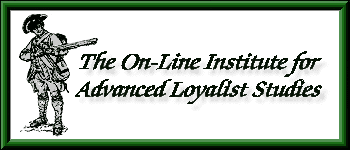

|
 |
| Skip directly to:
American Establishment, Militia, Volunteer Local Corps, Refugees and Associators |
Not All Loyalist Regiments |
|
The majority of Loyalist regiments were known as Provincials. A Provincial soldier was one who was raised for a fixed period of time (the duration of the war), was paid, clothed, armed, fed, etc. the same as a British soldier, was liable to the same military discipline and could serve anywhere in North America, although generally this meant only the provinces on the Atlantic between Nova Scotia and West Florida. Provincial regiments were those raised under the authority of the commander in chief in America, Canada or Jamaica. All commissions for officers were signed by this person. The regiment could be drafted or disbanded at his pleasure. Provincials received their clothing from the Inspector General of Provincial Forces and were mustered by the Muster Master General. In America, those gentlemen were Colonel Alexander Innes and Colonel Edward Winslow, respectively. Clothing and pay for the Provincials came through the Treasury Office as an extraordinary expense - that is, an expense over and above the normal costs of the army. The following regiments are examples of Provincial units:
Soldiers serving in Provincial units were volunteers, not conscripted.
The American Establishment Five regiments achieved this status between 1779 and 1781. These regiments were the:
These were named the 1st through 5th American Regiments respectively and could order their clothing directly from England instead of taking what they could get from the Provincial stores. Their buttons were generally marked with the number of their regiment. Their officers were automatically entitled to half pay and permanent rank in America upon the reduction of their corps. This establishment did not alter their pay, jurisdiction or form of muster.
Militia With the exception of the militia in the Carolinas, few of these units received pay or clothing. Units that did not receive pay were not mustered for such. Consequently, there is an absence today of muster rolls for the militia units. For instance, New York City and the five surrounding counties probably had in excess of seven thousand militiamen, but there are hardly any rolls for these units in existance today for this reason. However, rolls for some of the North and South Carolina militias do exist today, as they were in pay for part of their time in service. Militia regiments were technically the military domain of the governor of a province. For example, the militia of Georgia had commissions signed by Sir James Wright, their governor, and commissions for militia of Nova Scotia were signed by Francis Legge, their governor. Occasionally, this was impractical and others were empowered to sign, such as Colonel Nisbet Balfour in South Carolina or Major John Craig in the province to the north. Militia units were technically only for service in their native province, but occasionally cross border excursions were made. Militia service was most often compulsory, except for Quakers, firemen or exempt persons (such as justices of the peace.)
Volunteer Local Corps Examples of units considered to be volunteer local corps are the:
Refugees and Associators These units were sometimes commissioned by the commander in chief, but could also be commissioned by the commander of a garrison or even a governor. The men served without pay and mostly without uniforms. They were expected to earn their money and food by woodcutting, by procuring supplies for the British from the Rebels or by plundering. They were difficult to control and often fell outside the bounds of military discipline. Examples are the:
Click here for ---> Regiments List Main Page
The On-Line Institute for Advanced Loyalist Studies
|